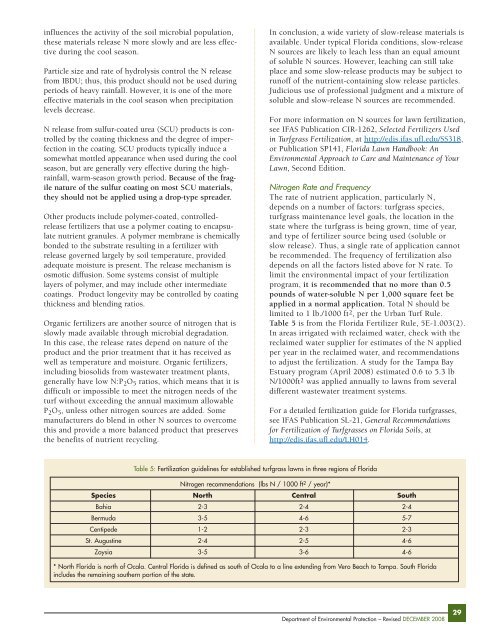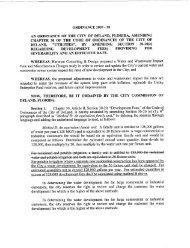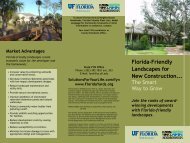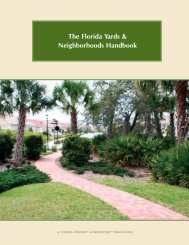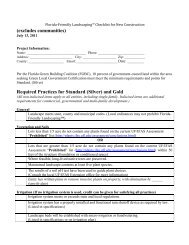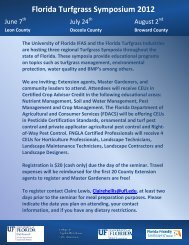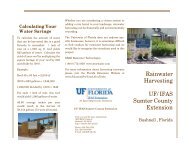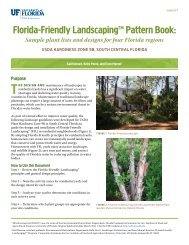soluble form. Some slowly available nitrogen productsare present. Stable aqueous solutions may be preparedfrom these materials. The reaction products shall containa maximum of fifty-five percent (55%) free urea,with the remainder of the urea being chemically combinedas methylolureas, methylolurea ethers, and/ormethylenediurea (MDU) and dimethylenetriurea(DMTU). (AAPFCO, Official 1984)• Methylenediurea (MDU) is a water soluble condensationproduct resulting from the reaction of one molecule offormaldehyde with two molecules of urea, with theelimination of one molecule of water. It has a minimumtotal nitrogen content of forty-two percent (42%)and is a source of slowly available nitrogen. (AAPFCO,Official 1984)• Dimethylenetriurea (DMTU) is a water soluble condensationproduct resulting from the reaction of two moleculesof formaldehyde with three molecules of urea,with the elimination of two molecules of water, andhaving a minimum total nitrogen content of forty-onepercent (41%). It is a source of slowly available nitrogen.(AAPFCO, Official 1984)• Dicyandiamide (cyanoguanidine) is a water solubleorganic compound of formula C 2 H 4 N 4 which containsat least sixty-five percent (65%) nitrogen. It is a sourceof slowly available nitrogen. It is a nitrificationinhibitor.( AAPFCO, Official 2000)• Polymer Coated Urea (PCU) is a coated slow release fertilizerconsisting of urea particles coated with a polymer(plastic) resin. It typically contains about fortypercent (40%) nitrogen. It is a source of slowly availablenitrogen. (AAPFCO, Official 1990)• Triazone is a water soluble compound of formulaC 5 H 11 N 5 O 2 [5-(N-methyl)-urea-1,3,5-triazin-2-one or5-methyleneureido-2-oxohexahydro-s-triazine] whichcontains at least forty percent (40%) total nitrogen.(AAPFCO, Official 1989)• Urea-Triazone Solution is a stable solution resultingfrom controlled reaction in aqueous medium of urea,formaldehyde, and ammonia which contains at leasttwenty-five percent (25%) total nitrogen. The solutionshall contain no more than forty percent (40%) nor lessthan five percent (5%) of total nitrogen from unreactedurea and not less than forty percent (40%) from triazone.All other nitrogen shall be derived from watersoluble, dissolved reaction products of the above reactants.It is a source of slowly available nitrogen.(AAPFCO, Official 1990)• Methylene Urea(s) (MU, polymethylene urea(s)) is aproduct obtained by the reaction of urea with formaldehydeand contains oligomers of urea bonded togetherFigure 19. Slow or quick release, this fertilizer is going to a water body.Keep fertilizer away from impervious surfaces and water bodies.by methylene (-CH 2 -) linkages. It is chiefly composedof cold-water soluble fractions from methylenediurea(MDU) and dimethylenetriurea (DMTU), hot watersoluble fractions from trimethylenetetraurea (TMTU)and tetramethylenepentaurea (TMPU) and hot-waterinsoluble fractions from longer chain oligomers. It isgenerally free of methylolureas and methyol ethers. Itis a source of slowly available nitrogen. (AAPFCO,Official 2001)Urea is often formulated using a chemical reaction orcoating to produce fertilizers with slow-release characteristics,such as ureaformaldehyde (UF or Nitroform),isobutylidene diurea (IBDU), and sulfur- or polymer-coatedurea. These fertilizers depend on microbial action, soilmoisture, and/or a chemical reaction for the release of Nfor use by turfgrass. It is important to know when to usea given slow-release N source in order to obtain maximumeffectiveness from the material. This is due to environmentalinfluences on the N-release mechanisms ofslow-release N sources.The N-release mechanism for methylene urea–typeproducts (Ureaformaldehyde, UF, Nitroform, Nutralene,Methex, or CoRon) is microbial. Because temperature28FLORIDA FRIENDLY BEST MANAGEMENT PRACTICES for Protection of Water Resources by the <strong>Green</strong> <strong>Industries</strong>
influences the activity of the soil microbial population,these materials release N more slowly and are less effectiveduring the cool season.Particle size and rate of hydrolysis control the N releasefrom IBDU; thus, this product should not be used duringperiods of heavy rainfall. However, it is one of the moreeffective materials in the cool season when precipitationlevels decrease.N release from sulfur-coated urea (SCU) products is controlledby the coating thickness and the degree of imperfectionin the coating. SCU products typically induce asomewhat mottled appearance when used during the coolseason, but are generally very effective during the highrainfall,warm-season growth period. Because of the fragilenature of the sulfur coating on most SCU materials,they should not be applied using a drop-type spreader.Other products include polymer-coated, controlledreleasefertilizers that use a polymer coating to encapsulatenutrient granules. A polymer membrane is chemicallybonded to the substrate resulting in a fertilizer withrelease governed largely by soil temperature, providedadequate moisture is present. The release mechanism isosmotic diffusion. Some systems consist of multiplelayers of polymer, and may include other intermediatecoatings. Product longevity may be controlled by coatingthickness and blending ratios.Organic fertilizers are another source of nitrogen that isslowly made available through microbial degradation.In this case, the release rates depend on nature of theproduct and the prior treatment that it has received aswell as temperature and moisture. Organic fertilizers,including biosolids from wastewater treatment plants,generally have low N:P 2 O 5 ratios, which means that it isdifficult or impossible to meet the nitrogen needs of theturf without exceeding the annual maximum allowableP 2 O 5 , unless other nitrogen sources are added. Somemanufacturers do blend in other N sources to overcomethis and provide a more balanced product that preservesthe benefits of nutrient recycling.In conclusion, a wide variety of slow-release materials isavailable. Under typical Florida conditions, slow-releaseN sources are likely to leach less than an equal amountof soluble N sources. However, leaching can still takeplace and some slow-release products may be subject torunoff of the nutrient-containing slow release particles.Judicious use of professional judgment and a mixture ofsoluble and slow-release N sources are recommended.For more information on N sources for lawn fertilization,see IFAS Publication CIR-1262, Selected Fertilizers Usedin Turfgrass Fertilization, at http://edis.ifas.ufl.edu/SS318,or Publication SP141, Florida Lawn Handbook: AnEnvironmental Approach to Care and Maintenance of YourLawn, Second Edition.Nitrogen Rate and FrequencyThe rate of nutrient application, particularly N,depends on a number of factors: turfgrass species,turfgrass maintenance level goals, the location in thestate where the turfgrass is being grown, time of year,and type of fertilizer source being used (soluble orslow release). Thus, a single rate of application cannotbe recommended. The frequency of fertilization alsodepends on all the factors listed above for N rate. Tolimit the environmental impact of your fertilizationprogram, it is recommended that no more than 0.5pounds of water-soluble N per 1,000 square feet beapplied in a normal application. Total N should belimited to 1 lb./1000 ft 2 , per the Urban Turf Rule.Table 5 is from the Florida Fertilizer Rule, 5E-1.003(2).In areas irrigated with reclaimed water, check with thereclaimed water supplier for estimates of the N appliedper year in the reclaimed water, and recommendationsto adjust the fertilization. A study for the Tampa BayEstuary program (April 2008) estimated 0.6 to 5.3 lbN/1000ft 2 was applied annually to lawns from severaldifferent wastewater treatment systems.For a detailed fertilization guide for Florida turfgrasses,see IFAS Publication SL-21, General Recommendationsfor Fertilization of Turfgrasses on Florida Soils, athttp://edis.ifas.ufl.edu/LH014.Table 5: Fertilization guidelines for established turfgrass lawns in three regions of FloridaNitrogen recommendations (lbs N / 1000 ft 2 / year)*Species North Central SouthBahia 2-3 2-4 2-4Bermuda 3-5 4-6 5-7Centipede 1-2 2-3 2-3St. Augustine 2-4 2-5 4-6Zoysia 3-5 3-6 4-6* North Florida is north of Ocala. Central Florida is defined as south of Ocala to a line extending from Vero Beach to Tampa. South Floridaincludes the remaining southern portion of the state.Department of Environmental Protection – Revised DECEMBER 200829
- Page 3 and 4: GOALS OF THE MANUALThis manual prov
- Page 5 and 6: Table of ContentsGOALS OF THE MANUA
- Page 7 and 8: Chapter 1: IntroductionUSING BEST M
- Page 9 and 10: these is performed properly, the ne
- Page 11: BMPs, job safety, and the specific
- Page 14 and 15: compacted by construction activity?
- Page 16 and 17: promotes deeper rooting, which is o
- Page 18 and 19: Protection, water management distri
- Page 21 and 22: IRRIGATION SYSTEM INSTALLATIONOnly
- Page 23 and 24: tion promotes deeper root developme
- Page 25 and 26: GREEN INDUSTRY IRRIGATION BMPSThe p
- Page 27 and 28: MOWING THE FLORIDA LAWNMowing is an
- Page 29 and 30: MANGROVESThree species of mangroves
- Page 31 and 32: Chapter 5: FertilizationFERTILIZER
- Page 33: cases, these stabilized N materials
- Page 37 and 38: nitrogen restrictions discussed ear
- Page 39 and 40: impervious surface that drains to a
- Page 41 and 42: The P content of the fertilizer sho
- Page 43 and 44: plastic container, mix them thoroug
- Page 45 and 46: think that less fertilization is al
- Page 47 and 48: help to establish proof of proper u
- Page 49 and 50: The best way to manage pesticide st
- Page 51 and 52: Segregate herbicides, insecticides,
- Page 53 and 54: pressure, size of nozzle, and spaci
- Page 55 and 56: MANAGEMENT OF PESTS IN THE LANDSCAP
- Page 57 and 58: ReferencesUnless otherwise mentione
- Page 59 and 60: Pruning Shade Trees in the Landscap
- Page 61 and 62: APPENDIX A: IMPORTANT TELEPHONE NUM
- Page 63 and 64: APPENDIX B: FLORIDA COOPERATIVE EXT
- Page 65 and 66: APPENDIX C: RULE 5E-1.003(2) LABELI
- Page 67 and 68: EMERGENCY REPORTING TELEPHONE NUMBE


